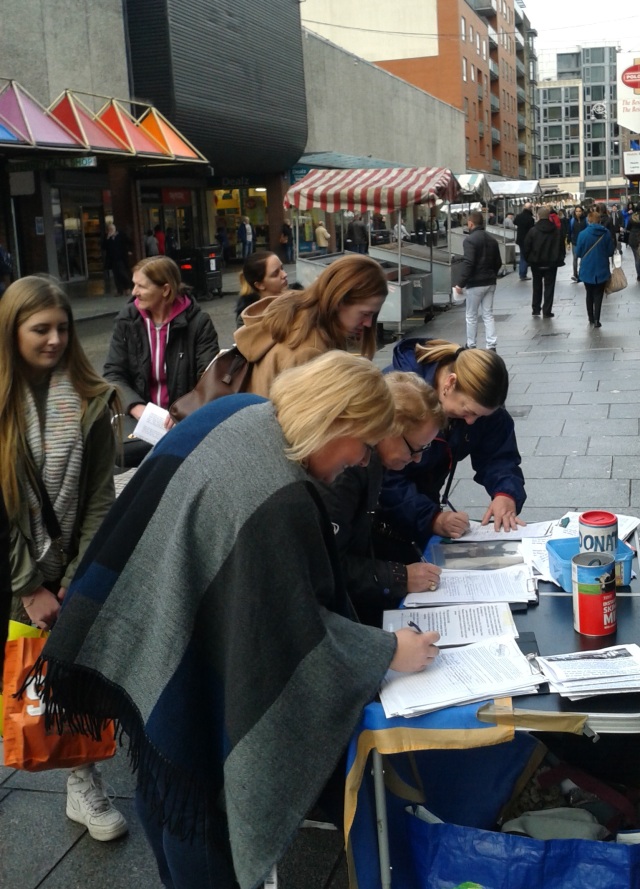Note: Text content reproduced by permission from Save Moore Street From Demolition, from their report on their Awareness Wk 255 3rd August 2019. The area has been the scene of a struggle between mainly historical conservationists and property speculators since 2002, the latter aided, campaigners say, by the Irish Government and the City Managers.
Save Moore Street Awareness Wk 255 3rd August 2019
A more depleted street market than usual greeted the campaigners while setting up our weekly campaign stall. A number of stall-holders had taken the opportunity of the bank holiday weekend to take a break; with Sunday and bank holiday Monday trading forbidden by their licences, the prospect of a long weekend was clearly attractive. Of course, the 17 or so licenses still issued by Dublin City Council does not at all compare with the 75 of some decades past but then that was bound to be an effect of permitting the erection of two supermarkets bracketing the street. Even more, having a thriving street market is not in the interests of those who want to demolish the quarter and construct a “shopping mall” or chain-store shopping district.

Our core team was depleted too, with Mary recovering from an injured knee and Mel on duties elsewhere; Bróna, Bart and Diarmuid set up this week.
Some long-time supporters stopped by to chat, including excellent photographer Errol, a man with extensive knowledge of wildlife, especially plants, who regularly drops by to distribute fresh fruit among us. As usual, people from different parts of Ireland, also migrants living here and visitors, signed the petition and talked about the importance of historical memory.

While putting two Irish-language posters together for a photograph for the Gaeilge Amháin Facebook page, on which understandably only Irish language is permitted, we hit upon the idea of placing the picture side of our leaflet upon it. It makes an attractive ensemble, don’t you think?
Meanwhile, news reaches us that the Minister’s Advisory Group on Moore Street has completed or is about to complete its report to the Minister, which basically backs the property speculator Hammerson’s ideas for the area. This is hardly surprising, sadly, considering how things go and have gone over the years but is a sad reflection on the management of this state. Apparently it was not all smooth sailing however, with disagreements about content and emphasis. One can see the sense, from the Minister’s point of view, of excluding our group from their list of approved stakeholders; less easy to understand, perhaps, is the acceptance by other members of her group of the exclusion of the most active Moore Street campaigning group in recent years.

PUB QUIZ
The prize (non-monetary) for naming four pubs in Moore Street’s past and their locations goes to Moore Street 1916 Battleground History Forum, a FB page supporting our campaign. Michael Shanley’s “pub with no name” was identified as “O’Neill’s” (probably not one of the current chain) by one of Troy’s Butcher’s team; it was diagonally across from them before being demolished to make way for the LIDL supermarket and underground shopping mall. Its corner was known for generations as “Dead Man’s Corner”, being near where the body of Volunteer commander O’Rahilly had lain with five bullets in his body, writing a goodbye note to his wife as he lay dying. The excellent monument now near the spot replaces the small plaque erected on the corner of the pub and reproduces not only The O’Rahilly’s words but also his very script, enlarged of course. But without any signage on Moore St. to indicate its presence, how many thousands must pass by unaware of its existence? Our campaigners have raised this with the Council but despite promises, no signage has yet been erected. After all, why call attention to the historical importance of an area when the City Managers support the property speculators wanting to demolish it?

That pub was the same one to which Vol. Tom Cremin had tried to gain entry, without success in 1916. The 18-year old had volunteered to join the O’Rahilly’s fatal charge on the British barricade located at the Moore Street junction with Parnell Street, on the way shooting a British soldier at the Salmon Lane junction. Vol. Cremin made it as far as what is now O’Rahilly Parade but had been wounded in the foot and the butt of his rifle had also been shot off. Seeking shelter, he entered possibly No.24 or 23 where he fed the dog he found there with some food in the house, lay upon a bed and fell asleep. When he awoke the following day, Easter Saturday, the Surrender had taken place and British soldiers were searching the houses for hidden fighters (there were none) and weapons.
The British soldier Vol. Cremin had shot further back down Moore Street had been carried, under fire, into No.10 by one of the three Plunkett volunteers, George. A field hospital had been set up in that house (of insufficient importance to save, according to the lawyers of the Minister for Heritage) by Vol. Elizabeth O’Farrell and Vol. Julia Grenan, in which around another 18 wounded were being cared for. The British soldier survived the Rising. Which was more than did one of George’s brothers, Joseph Plunkett, who was shot by British firing squad some days after the surrender, along with another 15 Volunteers in Ireland (Casement was hanged in August in London). The Seven Signatories of the Proclamation of Independence were among the executed and four of those spent their last days of freedom in the Moore Street battleground, along with another executed, Willie Pearse.
But what matters all that when there is big money to be made! There is lot more than adding “a halfpence to the pence” in their “greasy tills” these days.
Beimíd thar n-ais ar an tSráid arís an Satharn seo chugainn.
End.

